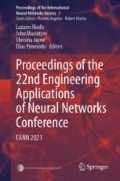Abstract
Computer vision has introduced new successful opportunities in everyday life. Recently, there has been a lot of progress, particularly in face recognition and object detection systems. These systems require a large amount of data to be trained with, in order to perform satisfyingly. Active learning addresses this challenge by leveraging a small amount of manually labelled data. This paper builds on state-of-the-art face recognition and object detection models, by implementing optimization techniques that enhance the recognition accuracy. Further training is being introduced by making use of a robust active learning framework that results in creating extended data sets. Finally, the paper proposes an integrated system, which involves efficient techniques of associating face and object identification information, in order to extract (in real-time) as much knowledge as possible from a video streaming.
Access this chapter
Tax calculation will be finalised at checkout
Purchases are for personal use only
References
Balaban, S.: Deep learning and face recognition: the state of the art. In: Biometric and Surveillance Technology for Human and Activity Identification XII (2015)
Girshick, R., Donahue, J., Darrell, T., Malik, J.: Region-based convolutional networks for accurate object detection and segmentation. In: Transactions on Pattern Analysis and Machine Intelligence, vol. 38, no. 1, pp. 142–158. IEEE Computer Society, Washington (2016)
Sener, O., Savarese, S.: Active Learning for Convolutional Neural Networks: A Core-Set Approach. In: ArXiv.org (2018), arXiv:1708.00489. Accessed 13 Dec 2020
Schroff, F., Kalenichenko, D., Philbin, J.: FaceNet: a unified embedding for face recognition and clustering. In: International Conference on Computer Vision and Pattern Recognition (CVPR). IEEE Computer Society, Washington (2015)
Learned-Miller, E., Huang, G.B., Roychowdhury, A., Li, H., Hua, G.: Labeled Faces in the Wild: a survey. In: Advances in Face Detection and Facial Image Analysis, pp. 189–248 (2016)
Baltrusaitis, T., Robinson, P., Morency, L. P.: OpenFace: an open source facial behavior analysis toolkit. In: International Conference on Applications of Computer Vision (WACV). IEEE Computer Society, Washington (2016)
Suwarno, S., Kevin, K.: Analysis of face recognition algorithm: Dlib and OpenCV. J. Inform. Telecommun. Eng. 4(1), 173–184 (2020)
He, K., Zhang, X., Ren, S., Sun, J.: Deep residual learning for image recognition. In: International Conference on Computer Vision and Pattern Recognition (CVPR). IEEE Computer Society, Washington (2016)
Fei-Fei, L., Deng, J., Li, K.: ImageNet: constructing a large-scale image database. J. Vis. 9(8), 1037–1037 (2010)
Nelson, D.: How does image classification work?. In: Unite.AI (2020). https://www.unite.ai/how-does-image-classification-work/. Accessed 16 Dec 2020
Hurtik, P., Molek, V., Vlasanek, P.: YOLO-ASC: you only look once and see contours. In: International Joint Conference on Neural Networks (IJCNN) (2020)
Lin, T.Y., et al.: Microsoft COCO: common objects in context. In: Microsoft Research (2018). https://www.microsoft.com/en-us/research/publication/microsoft-coco-common-objects-in-context/#!abstract. Accessed 17 Oct 2018
Szegedy, C., et al.: Going deeper with convolutions. In: International Conference on Computer Vision and Pattern Recognition (CVPR). IEEE Computer Society, Washington (2015)
Everingham, M., Gool, L.V., Williams, C.K.I., Winn, J., Zisserman, A.: The Pascal Visual Object Classes (VOC) Challenge. Int. J. Comput. Vis. 88(2), 303–338 (2009)
Gad, A.F.: Faster R-CNN explained for object detection tasks. In: Paperspace Blog (2020). https://blog.paperspace.com/faster-r-cnn-explained-object-detection/. Accessed 14 Dec 2020
He, K., Gkioxari, G., Dollár, P., Girshick, R.: Mask R-CNN. In: ArXiv.org (2018), . Accessed 14 Dec 2020
Gordon, D., Farhadi, A., Fox, D.: Re\(^3\): real-time recurrent regression networks for visual tracking of generic objects. In: Robotics and Automation Letters, vol. 3, no. 2, pp. 788–795. IEEE Computer Society, Washington (2018)
Nebehay, G., Pflugfelder, R.: Clustering of static-adaptive correspondences for deformable object tracking. In: International Conference on Computer Vision and Pattern Recognition (CVPR). IEEE Computer Society, Washington (2015)
Rosebrock, A.: Facial landmarks with Dlib, OpenCV, and Python. In: PyImageSearch (2020). https://www.pyimagesearch.com/2017/04/03/facial-landmarks-dlib-opencv-python/. Accessed 14 Dec 2020
Li, H., Wang, P., Shen, C.: Robust face recognition via accurate face alignment and sparse representation. In: International Conference on Digital Image Computing: Techniques and Applications (2010)
Zhang, S., Qiao, H.: Face recognition with support vector machine. In: International Conference on Robotics, Intelligent Systems and Signal Processing, vol.2, pp. 726–730. IEEE Computer Society, Washington (2003)
Setiawan, E., Muttaqin, A.: Implementation of K-nearest neighbors face recognition on low-power processor. In: Telecommunication Computing Electronics and Control (TELKOMNIKA), vol. 13, no. 3, p. 949 (2015)
Acknowledgement
This paper is a result of research conducted within the “MSc in Artificial Intelligence and Data Analytics” of the Department of Applied Informatics of University of Macedonia. The presentation of the paper is funded by the University of Macedonia Research Committee.
Author information
Authors and Affiliations
Corresponding author
Editor information
Editors and Affiliations
Rights and permissions
Copyright information
© 2021 The Author(s), under exclusive license to Springer Nature Switzerland AG
About this paper
Cite this paper
Tzogka, C., Refanidis, I. (2021). Addressing Computer Vision Challenges Using an Active Learning Framework. In: Iliadis, L., Macintyre, J., Jayne, C., Pimenidis, E. (eds) Proceedings of the 22nd Engineering Applications of Neural Networks Conference. EANN 2021. Proceedings of the International Neural Networks Society, vol 3. Springer, Cham. https://doi.org/10.1007/978-3-030-80568-5_22
Download citation
DOI: https://doi.org/10.1007/978-3-030-80568-5_22
Published:
Publisher Name: Springer, Cham
Print ISBN: 978-3-030-80567-8
Online ISBN: 978-3-030-80568-5
eBook Packages: Intelligent Technologies and RoboticsIntelligent Technologies and Robotics (R0)

